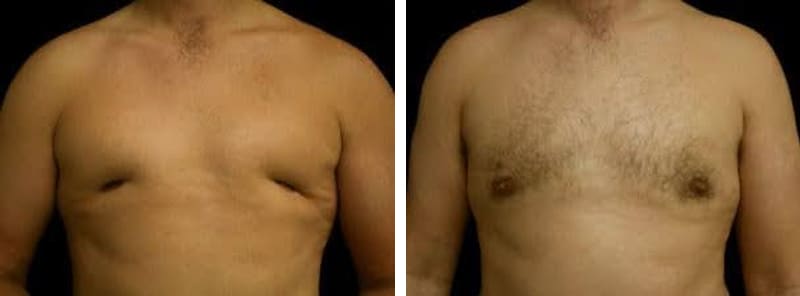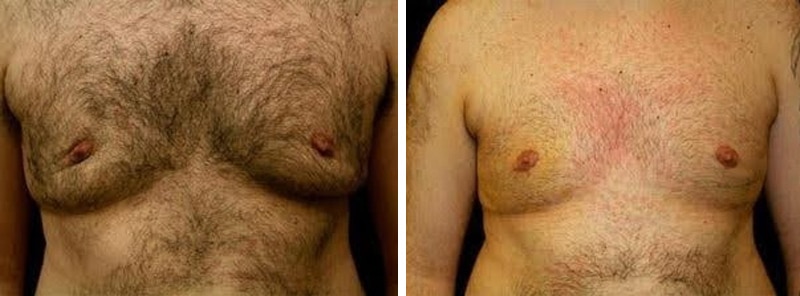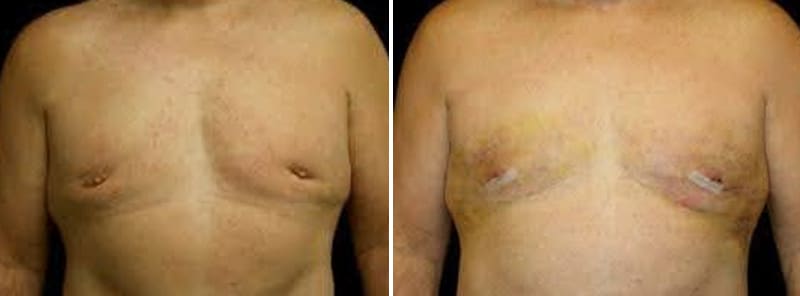Crater Deformity After Gynecomastia Surgery: Causes & Effective Fixes

A crater deformity after gynecomastia surgery is an indentation in the chest that occurs when too much breast tissue or fat is removed or the skin heals under tension. These depressions can distort the chest’s natural contour. This article explores the causes, impacts, and possible treatments for understanding what constitutes a crater deformity following gynecomastia surgery.
Quick Facts About Crater Deformities After Gynecomastia Surgery
- Crater deformity is an indentation in the chest wall that can occur after gynecomastia surgery due to aggressive tissue removal or improper healing. It can impact physical appearance and psychological well-being.
- Key causes of crater deformities include excessive removal of breast gland tissue, over-aggressive liposuction, and scar tissue formation, each of which contributes to contour irregularities.
- Treatment options for correcting crater deformities include fat transfer techniques, fat flap techniques, and revision gynecomastia surgery emphasize the need for personalized surgical approaches and careful post-surgical care.
What Causes Crater Deformities After Gynecomastia Surgery?

Crater deformity manifests as a concavity in the chest wall and typically emerges after gynecomastia surgery when there is an imbalance in fat removal or excess skin tension during recovery. These indentations interfere with the chest’s smooth contour, creating noticeable dips or “crater deformities” that can lessen the aesthetic satisfaction for individuals who have undergone this procedure.
Gynecomastia patients who undergo surgery to improve their chest appearance may face challenges due to crater deformities. Such irregularities can stem from unbalanced or excessively vigorous liposuction efforts that disturb the natural line of the chest. A hollow effect occurs if excessive breast gland tissue is removed without properly blending it into adjacent fat tissues, which may be highlighted by undue skin tightness or scar contraction during healing.
The physical impact of crater deformity extends beyond altering one’s physique—it can impart considerable psychological distress to patients disappointed with their initial surgery results. Identifying and addressing the causes of these complications is essential for correcting them and ensuring.
Top Causes of Crater Deformities After Male Breast Surgery
Overly enthusiastic removal of tissue during male breast reduction surgery is the primary cause of crater deformities. These contour irregularities can result from removing too much breast gland, engaging in overzealous liposuction, or the creation of scar tissue.
Understanding these contributing factors is essential for preventing such outcomes and also critical for treating them effectively if they occur.
How Over-Removal of Breast Tissue Causes Crater Deformities
A key factor leading to the onset of crater deformity following gynecomastia surgery is the overzealous excision of male breast tissue. This condition typically arises when surgical techniques are improperly applied or if the surgeon, with an aim to remove all traces of breast tissue, takes away too much. The result is a disproportionate chest structure that often presents as a recessed or indented area.
These contour changes become particularly noticeable when the skin sags over areas where excessive glandular tissue has been removed. For individuals undergoing treatment for gynecomastia, this can lead to significant physical and psychological discomfort, diminishing their contentment with the surgery’s outcomes, and frequently necessitating additional operations for correction.
How Over-Aggressive Liposuction Creates Chest Indentations

When gynecomastia surgery involves excessively forceful uneven liposuction, it can lead to the formation of crater deformities. Such outcomes occur due to removing too much fat, which leads to pronounced contour irregularities that appear as depressions on the chest wall and detract from its visual appeal.
Conversely, failing to eliminate sufficient fat during surgery can lead to comparable indentations on the chest. The success in achieving an even chest contour depends on striking a precise balance between removing excess fat and preserving enough tissue. This underscores the critical nature of skilled technique and substantial experience in conducting gynecomastia surgery to prevent these issues.
The Role of Scar Tissue in Crater Deformities
Scar tissue development is expected in the recovery phase after any surgical intervention, such as gynecomastia treatment. When this tissue is overproduced, it can cause inconsistencies in the chest’s appearance and lead to crater deformities. Thus, controlling scar tissue formation is essential for satisfactory cosmetic results.
During the recuperative period following surgery, excessive scar tissue may form, preventing the skin from retracting smoothly across the chest area. This issue can result in a hollow or sunken appearance on the chest surface, highlighting the importance of surgeons’ effective management and anticipation of scar tissue during the post-operative healing phase.
Effective Treatments for Crater Deformities After Gynecomastia Surgery
Several strategies can be employed to correct crater deformities following gynecomastia surgery, including fat grafting methods, fat flap procedures, and secondary gynecomastia surgery. All these techniques aim to rectify the concavities and restore a more even contour to the chest.
How Fat Grafting Corrects Crater Deformities
Fat transfer involves collecting fat from a different body part and administering it to the chest to address depressions. Also known as fat grafting, this approach is an effective remedy for smoothing out contour irregularities using the patient’s own tissue. Structural fat grafting can restore areas of persistent soft tissue depression caused by crater deformity. This method reduces the risk of rejection and provides long-lasting results.
Alternatively, a fat flap surgery involves shifting nearby adipose tissue to rectify any cavities present. This method is frequently successful in providing long-term correction and substantially enhances the visual appeal of the chest area. To ensure optimal results with both techniques, it’s crucial that they are performed with precision to achieve seamless integration of fat and restoration of even contours.
Using Fat Flap Techniques to Restore Chest Contours

The fat flap technique involves transferring a substantial section of fat tissue, along with its inherent blood supply, from an adjacent area to fill in the depressed section.
This method guarantees the transplanted fat tissue remains healthy and seamlessly melds with nearby tissues. The continuous blood flow is instrumental in providing a lasting remedy for correcting pronounced depressions and achieving an even contour across the chest.
This strategy is especially advantageous for patients who have undergone considerable tissue removal or extensive liposuction. It offers a solid means of reconstructing the natural shape of the chest. The enduring viability of transferred fat tissue is crucial for this procedure’s success, making it a reliable choice for sustained correction.
What to Expect from Revision Gynecomastia Surgery
In cases where the original gynecomastia surgery leads to noticeable contour irregularities or the development of crater deformities, revision gynecomastia surgery or secondary gynecomastia surgery becomes imperative. The goal of this follow-up operation is to eliminate remaining excess fatty tissue and refine skin elasticity, enhancing the aesthetics of the chest area. To secure optimal outcomes from corrective surgery, it’s critical that patients have completely healed from their initial surgery.
To promote favorable results, revision surgery for gynecomastia requires surgeons who are exceptionally knowledgeable about both preoperative preparation and postoperative care. Crater deformities after such revision surgery can profoundly affect an individual’s mental well-being. Therefore, addressing these imperfections is vital not only for restoring physical appearance, but also for supporting emotional recovery after surgery.
How to Choose the Best Surgeon for Crater Deformity Correction
Selecting a skilled and experienced surgeon is crucial for effectively preventing and correcting crater deformities after gynecomastia surgery. This corrective surgery is more complicated than the initial treatment, especially for crater deformity after gynecomastia surgery. This underscores the necessity for patients to opt for a board-certified plastic surgeon who specializes in gynecomastia-related procedures.
For optimal results in male breast reduction surgeries, it is imperative that patients seek out surgeons with an extensive record of positive outcomes. In addition to proficiency in surgical techniques, it is vital that the selected plastic surgeon provides customized treatment plans and conducts thorough evaluations before surgery to ensure satisfactory postoperative outcomes.
Why Specialized Expertise Matters for Crater Deformity Surgery

Surgeons must possess specialized expertise in gynecomastia surgery to achieve a successful outcome. Comprehensive training in liposuction and precise breast tissue removal is essential for creating a well-balanced and visually appealing chest contour.
A board certified plastic surgeon is the best choice.
Dr. Delgado is a prominent expert among San Francisco’s gynecomastia specialists and is renowned across the United States. With over 30 years of experience and having treated more than 5,000 patients, he is highly regarded in the field. Notably, revision surgery comprises 40% of his practice. He is skilled in advanced techniques, like the fat flap method, that transplant a portion of fat tissue along with its blood supply to a specific site on the chest, as well as using refined liposuction equipment for harvesting and transferring fat into the chest region during surgery.
In handling revision procedures, Dr. Delgado’s team emphasizes exceptional patient support throughout the recovery journey. They are committed to providing outstanding surgical outcomes that ensure patients feel confident and satisfied with the care they receive.
The Importance of Personalized Treatment Plans
Creating a personalized treatment plan is crucial for achieving the best results in secondary or revision gynecomastia surgery. These intricate cases require a thorough evaluation of the patient’s unique anatomical challenges and previous gynecomastia surgeries, which then formulate the surgical approach.
Dr. Delgado prioritizes this individualized methodology for all his cosmetic operations, ensuring that each plan is crafted with careful consideration of each patient’s distinctive needs and aspirations.
Consultations involve thorough evaluations designed to create a tailored surgical plan for each patient. This plan considers various factors, such as the amount of tissue to be removed, existing scar tissue, and the desired aesthetic outcomes. Adapting surgery plans in this way increases the probability of achieving both successful procedural results and fulfillment of patient expectations following gynecomastia surgery.
Why Preoperative Assessments Are Critical for Revision Surgery
A comprehensive preoperative assessment is essential for crafting successful corrective strategies, enabling surgeons to foresee and manage potential complications. During gynecomastia surgery, it is crucial to focus on procedural aspects.
In discussions regarding revision gynecomastia surgery, elements including the patient’s medical history, degree of scarring from previous surgeries, and desired aesthetic outcomes are evaluated. This thorough analysis helps structuring an effective surgical plan that aims to reduce the likelihood of crater deformities, while striving for optimal results tailored to the patient’s expectations.
Post-Surgery Recovery for Crater Deformities
The healing process following gynecomastia surgery is heavily dependent on achieving the best possible outcomes. If it does not proceed as expected, a crater deformity may develop due to the skin’s inability to retract properly after surgery.
Understanding the recovery process and knowing how to care for yourself after surgery are crucial components that can significantly impact your final results.
Essential Post-Surgery Care for Preventing Crater Deformities

Following post-operative care instructions is essential for a smooth recovery and minimizing potential complications after surgery. Wearing a compression garment after the procedure is crucial for reducing swelling and supporting the tissue healing process.
Adhering to your surgeon’s instructions for pain management and wound care is essential for promoting proper healing and avoiding negative outcomes. Effectively managing scar tissue development is crucial, because excessive scar tissue can hinder the skin’s ability to retract, potentially leading to crater deformities on the chest.
What to Expect During Gynecomastia Recovery
Recovery times post-surgery differ from individual to individual, but most patients can engage in light tasks within one to two weeks following their operation. Those with desk jobs could return within three to seven days, although complete recovery could extend over several months. Patients benefit from recognizing this timeline, as it allows feasible expectations and adequate planning.
Many individuals may notice swelling and discoloration in the early stages after surgery. These symptoms typically diminish over a few weeks. During this phase, patience is essential as the body heals and adapts progressively, ultimately unveiling the definitive outcomes of the surgical procedure.
How to Manage Emotional Challenges After Surgery
Addressing psychological distress is a key element in the postoperative phase for individuals who have had gynecomastia surgery. Worries about one’s looks and the progression of recovery can lead to feelings of anxiety or depression, which may require psychological support. It is crucial to treat these emotional impacts with the same seriousness as physical recovery.
A boost in self-assurance often follows corrective surgery for many patients, especially when crater deformities have been effectively remedied. Keeping track of any emotional shifts following the operation and seeking assistance when necessary can greatly enhance the recovery process, helping patients feel assured and pleased with their surgical outcomes.
Get Expert Help for Crater Deformities with a Free Consultation

Dr. Delgado offers a complimentary consultation to individuals dealing with crater deformities due to gynecomastia surgery. With his board certification in plastic surgery and an impressive 30-year track record, Dr. Delgado has successfully assisted more than 5,000 patients in accomplishing their sought-after chest contour.
Dial 415-898-4161 now to book your consultation and embark on the journey toward attaining a refined and assured chest appearance through expert surgical care.
Key Takeaways: Preventing and Treating Crater Deformities
Understanding crater deformity after gynecomastia surgery is crucial for achieving the best possible outcomes and ensuring patient satisfaction. By recognizing the causes, such as excessive tissue removal, aggressive liposuction, and scar tissue formation, patients and surgeons can work together to prevent these issues. When crater deformities occur, treatment options like fat transfer, fat flap techniques, and revision surgeries offer effective solutions.
Choosing the right surgeon, such as Dr. Delgado, and following a personalized treatment plan, including thorough preoperative assessments and diligent post-surgery care, are essential steps in achieving optimal results. By managing both the physical and psychological aspects of recovery, patients can look forward to a renewed sense of confidence and well-being.
FAQs About Crater Deformities and Gynecomastia Surgery
What Causes Crater Deformities After Male Breast Surgery?
A crater deformity, which occurs after gynecomastia surgery, is an indentation in the chest area underneath the nipple. It occurs due to uneven tissue removal or insufficient healing.
This condition highlights the importance of precise surgical technique and proper post-operative care.
How can crater deformities be prevented during gynecomastia surgery?
When undergoing gynecomastia surgery, it is crucial to utilize meticulous surgical methods, achieve equilibrium in tissue removal, and handle scar tissue appropriately to avert crater deformities.
For the best results, it is equally important to choose a board-certified plastic surgeon with substantial experience.
What are the treatment options for correcting crater deformities?
Fat transfer techniques, fat flap techniques, and revision gynecomastia surgery are viable treatment options for correcting crater deformities. Each provides a unique approach to enhancing chest contour.
How long does it take to recover from gynecomastia surgery?
Recovery from gynecomastia surgery typically allows patients to return to light activities in one to two weeks, while full recovery may take several months.
Following post-surgery care instructions is crucial for achieving optimal results.
Why is psychological support important after gynecomastia surgery?
After undergoing gynecomastia surgery, it is vital for patients to receive psychological support to manage any possible feelings of anxiety or depression related to their physical appearance. This type of emotional aid can significantly improve the recovery process and contribute positively to the patient’s well-being. This is beneficial for teenagers.
